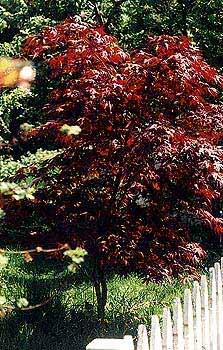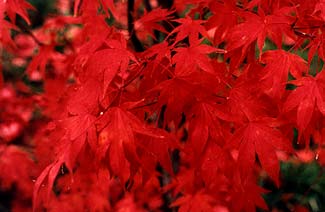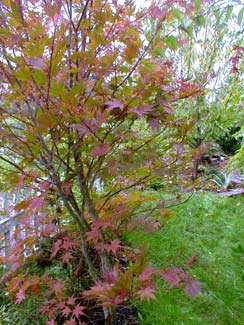 'Oshio Beni'
'Oshio Beni'
Red Japanese Maple
"The maple's loom is red."
-Emily Dickinson
1830-1886
"What is to be my legacy?
Spring flowers, summer's cuckoo,
& autumn's crimson maples."
Ryokan Taigu
(1758-1831)
1830-1886
(1758-1831)
We have two purple or red Japanese maples. One is a young Ace palmatum ssp amoenum 'Oshio Beni' about seven feet tall as shown in the May 2002 portrait at the top of this page, & putting on a foot of height each year. It is quite bushy with full sized maple leaves called "palmate" or hand-shaped, which is the basis of the species name as well.
The fingers of the "palm" are wider than the majority of purple or red Japanese maples. New spring leaves are a particularly striking deep purple that does not much fade as summer heightens, becoming bronzy at the height of summer. Then in autumn it turns the most intense bright red, hence it's name, 'Oshio Beni,' which means "great red tide."
The second photo shows the Great Red Tide at the peak of color, in November. For more Autumn portraits, see the 'Oshio Beni' page of the Autumn Trees Gallery.
At eight feet height as of early 2003, it was still more like a wonderful big shrub a tree, a shrub that turns from spring & summer purple to the most startling autumn red, as can be seen in the second figure, a November leaf portrait of the same little tree.
The first two photos show it in its finest spring purple & its finest late-autumn red, but before it turns red in November, its color in September & October fades from its earlier uniform dark purple to a mix of light purple, pink, & green, before turning fiery red. The third photo shows it in October (2004) in the pre-fiery colors. It is by this time nine feet or ten feet tall, & not so bushy from having been thinned down & trained to be more of a classic maple tree.
 If Japanese maples experience a premature harsh or extended freeze in autumn, the leaves may die on the branches without finishing up turning their brightest reds, & these crisp brown leaves will cling to the branches until pushed off by new leaf-buds in spring. The one year we had an unusually frigid early autumn, this very thing happened to 'Oshio Beni,' & I worried it had suffered from the infamous Sudden Death Syndrome caused by fungus wilt. About a third of the Japanese maples around the county also had their leaves frozen before reaching their fullest red, & a complete leaf-fall went uncompleted. This hasn't happened again, but next time we have an extra-cold early autumn, I won't be so surprised when the leaves turn brown without falling.
If Japanese maples experience a premature harsh or extended freeze in autumn, the leaves may die on the branches without finishing up turning their brightest reds, & these crisp brown leaves will cling to the branches until pushed off by new leaf-buds in spring. The one year we had an unusually frigid early autumn, this very thing happened to 'Oshio Beni,' & I worried it had suffered from the infamous Sudden Death Syndrome caused by fungus wilt. About a third of the Japanese maples around the county also had their leaves frozen before reaching their fullest red, & a complete leaf-fall went uncompleted. This hasn't happened again, but next time we have an extra-cold early autumn, I won't be so surprised when the leaves turn brown without falling.Obviously, in zones with colder autumns, Japanese maples may never achieve their full autumn colors. Though the species is theoretically growable down to Zone 5, it is at its best in Zone 8 where autumn & winter is mild. This makes the coastal Northwest just about the best place other than Japan to grow them, & Northwesterns respond to this fact by planting thousands of them. They never seem a cliche tree to have, however, because the hundreds of available cultivar varieties can be so extremely different one to the next, & they can be trained in so many varied ways. It remains that for people who live colder zones, the Korean Maple Acer pseudosieboldianum would be a better choice. Although the range of amazing cultivars is lacking, its autumn colors are more reliable for the colder climates.
 'Oshio Beni' is an old variety introduced in 1898, & is of the Amoenum Group. Although like the majority of Japanese maples it can scald in full sun, & would prefer at leasta small portion of shade, ours gets full sun exposure in the afternoon, which for Puget Sound & the coast does not bother it in the least, though inland it would be much more stressed by full sun.
'Oshio Beni' is an old variety introduced in 1898, & is of the Amoenum Group. Although like the majority of Japanese maples it can scald in full sun, & would prefer at leasta small portion of shade, ours gets full sun exposure in the afternoon, which for Puget Sound & the coast does not bother it in the least, though inland it would be much more stressed by full sun.It will someday be a tree rather than a shrub in size. For comparison, you can see our much, much larger Japanese maple. It is twenty-odd feet tall & has a separate page of portraits. 'Oshio Beni' will also exceed 20 feet someday, this particular cultivar having an upright stance with a tendency to develop a spreading top.
As of 2004, we have done about four years of shaping 'Oshio Beni' through pruning, or it would be even more densely foliaged. Granny Artemis has done most of the shaping of this tree, though I've verbally put in my two-cents worth each time she approached it with sheers.
The pruning has been awfully conservative for fear of doing too much. By 2004 it was really beginning to have the form of a shapely small tree rather than a thickly leafed shrub, thus reaching a new level of beauty.
The Japanese call maples with red or purple leaves "Momiji" the Frog-hand; other maples are called "Kaede" (Kah Eh Deh), the Baby's Hand. Interest in these trees was extremely high in Japan & China in the 1700s & 1800s, when there were even more named cultivars than today,
Momijigari or Autumn Maple Viewing Festival in Shiga Prefecture provides one of the most popular of Japanese holidays. Maple is in particular sacred in Hiroshima & Yamanashi, & to the holy city of Nara. The purple & red leaves of the Momijioro (Red Frog Hands) are their brightest colors in autumn, & crowds of people arrive at temples & parks & relax at key viewing sites, everywhere in Japan but especially throughout Shiga Prefecture.
This is the most important festival occasion to mark the season. In spring it would be Cherry-blossom viewing, in summer it would be listening to Cicadas while traditional ghost stories are told (which are supposed to "chill" the overheated listener in the hot month), & in winter it would be visits to key temples with famous evergreens, with different evergreens sacred in different prefectures, but most especially the Sugi (Cedar) which is regarded a strong god-like man much as Momiji is a divine court lady in brocaded robes, cherry blossoms are brave but fragile young soldiers or samurai, & summer's cicadas give voice to the dead, placated on Bon Odori, the ghost-festival.
The ancient pantheistic Shinto sense that all things are alive & sentient, providing bridges between the supernatural world & the natural world, is a sentimental religiosity more acute to the Japanese than to most Americans, though perhaps equally reflected in some Native American attitudes toward nature.
It is not unusual in Japan that trees & stones or natural monuments are given "wedding ceremonies," as when a rope made from school girls' donated hair is used to tie an interesting-looking rock (husband) to a beautifully formed maple (bride). The attitude that underlies such nature-marriages is felt even by the nominally areligious, as there is not a great devision between active faith & "mere" aesthetic beauty.
Japanese maples have hundreds of cultivars some of them so different from one another it is surprising to realize they're the same species. We also have a semi-dwarf cultivar A. palmatum 'Shishigashira' the Lion's Head Maple that with small deeply cut bright yellow-green leaves just couldn't look any different from 'Oshio Beni.'